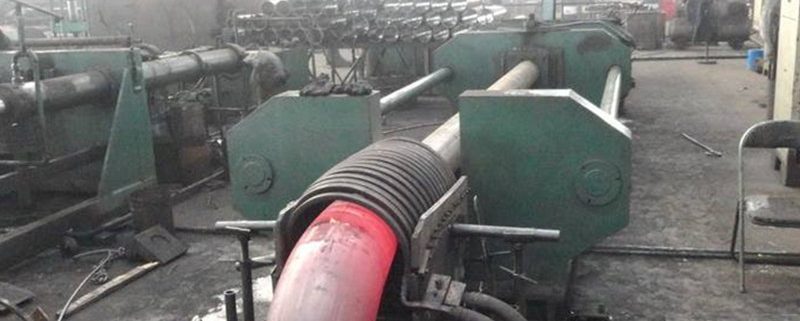Process flow of making elbow
Process flow of making elbow
Seamless elbow: an elbow is a pipe fitting used at the turn of a pipe. The proportion of all pipe fittings used in the pipeline system is large, about 80%. Generally, different forming processes are selected for elbows with different materials or wall thickness. The common forming processes of seamless elbow in manufacturers include hot pushing, stamping, extrusion and so on.
Hot push forming
The hot push elbow forming process is a process of heating, expanding and bending the blank sleeved on the die under the push of the special elbow pushing machine, core die and heating device. The deformation characteristic of the hot push elbow is to determine the diameter of the pipe blank according to the law that the volume remains unchanged before and after the plastic deformation of the metal material. The diameter of the pipe blank used is less than the diameter of the elbow. The deformation process of the blank is controlled through the core die to make the compressed metal flow at the inner arc and compensate to other parts thinned due to diameter expansion, so as to obtain the elbow with uniform wall thickness.
The forming process of hot push elbow has the characteristics of beautiful appearance, uniform wall thickness and continuous operation, which is suitable for mass production. Therefore, it has become the main forming method of carbon steel and alloy steel elbow, and is also used in the forming of some specifications of stainless steel elbow.
The heating methods of the forming process include medium frequency or high frequency induction heating (the heating ring can be multi circle or single circle), flame heating and reverberatory furnace heating. The heating method depends on the requirements of the formed products and energy conditions.
Stamping forming
Stamping formed elbows have long been used in the forming process of mass production of seamless elbows. They have been replaced by hot pushing method or other forming processes in the production of common specifications of elbows. However, in some specifications of elbows, the production quantity is small, the wall thickness is too thick or too thin.
The product is still in use when there are special requirements. The pipe blank with the same outer diameter of the elbow is used for the stamping forming of the elbow, and the press is used to directly press and form in the die.
Before stamping, the tube blank is placed on the lower die, the inner core and end die are installed into the tube blank, the upper die moves downward and begins to press, and the elbow is formed through the restraint of the outer die and the support of the inner die.
Compared with the hot pushing process, the appearance quality of stamping forming is not as good as the former; When the stamping elbow is formed, the outer arc is in the tensile state, and there is no excess metal in other parts to compensate, so the wall thickness at the outer arc is reduced by about 10%. However, due to the characteristics of single piece production and low cost, the stamping elbow process is mostly used for the manufacture of small batch and thick wall elbows.
Stamping elbows are divided into cold stamping and hot stamping. Cold stamping or hot stamping is usually selected according to the material properties and equipment capacity.
The forming process of cold extrusion elbow is to use a special elbow forming machine to put the pipe blank into the outer die. After the upper and lower dies are closed, the pipe blank moves along the gap reserved by the inner die and the outer die under the push of the push rod to complete the forming process.
The elbow manufactured by internal and external die cold extrusion process has beautiful appearance, uniform wall thickness and small size deviation. Therefore, this process is often used for the forming of stainless steel elbow, especially thin-walled stainless steel elbow. The precision of internal and external die used in this process is high; The requirements for wall thickness deviation of pipe blank are also strict.
Medium plate welding
Use the medium plate to make half of the elbow section with a press, and then weld the two sections together. This process is generally used for elbows above DN700.
Other forming methods
In addition to the above three common forming processes, seamless elbow forming also adopts the forming process of extruding the tube blank to the outer die and then shaping through the ball in the tube blank. However, this process is relatively complex, troublesome to operate, and the forming quality is not as good as the above process, so it is rarely used.




